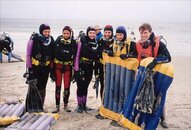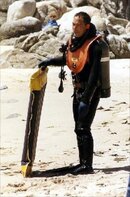One of the best tools for safe shore entries and exits I've used is an old-school "surf mat". These were a fixture on California beaches back in the '60s. The original purpose of the mat was for surfing, much like a boogie board, but it turned out to be a great tool for shore diving as well.
Some photos from the old days at Monastery Beach.
View attachment 176037View attachment 176036
By the late '70s nobody surfed with these mats anymore (boogie boards worked way better) but we continued diving with them well into the '90s.
For beach entries, the mat would get you up and over breaking waves, and past the surf zone quickly. For rock entries, it provided a lot of flotation, so you could kick out in very shallow water instead of stumbling through to snorkeling depth.
For beach exits, you could literally "surf" waves that would deliver you far up the beach. Then stand up, turn around and shuffle backwards. And for rock exits, you could kick in much closer to the water's edge, to minimize stumbling through the shallow rocks.
Oh, and the mat also made long surface swims a breeze. And it was a great platform for rescues.
These mats are long gone. Nobody uses them any more. However, in years of shore diving sometimes very heavy conditions in Carmel/Monterey, I never saw a person using one get worked over in the surf. During those same years, we ended up rescuing lots of "crawlers" getting pummeled by shorebreak.
Laugh all you want, but these things were great. I actually still have two in my garage, and used one as recently as 2011 on a pretty big day at La Jolla Shores.






